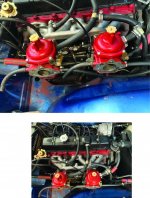FR Burkhart
Member
Offline
After multiple attempts in my garage and a couple weeks at a local shop, I still have challenges getting my TR6 running smoothly. When starting from a stop, the engine sputters. The sputter decreases as the rpms increase but still there up to 2,000-2,500 rpms. Even freeway driving, I can feel an occasional misfire/sputter. If full out acceleration, no sputter. With the throttle wide open, runs beautifully up to 5,000 rpm. And, idles well at 900 to 1,000 rpm.
At this point - replaced alternator, coil, distributor cap and rotor (electronic ignition) and spark plug wires. Replaced the fuel pump with electric pump. Carbs have been stripped down with new gaskets, diaphragm and floats. Bypass valve diaphragm replaced. Checked for vacuum leaks.
Known problem is the brake booster - idle drops when brake pressed and a nice hissing sound. Rebuilt brake booster on order from Apple Hydraulics.
What am I missing?
Thank you any help.
Frank Burkhart
At this point - replaced alternator, coil, distributor cap and rotor (electronic ignition) and spark plug wires. Replaced the fuel pump with electric pump. Carbs have been stripped down with new gaskets, diaphragm and floats. Bypass valve diaphragm replaced. Checked for vacuum leaks.
Known problem is the brake booster - idle drops when brake pressed and a nice hissing sound. Rebuilt brake booster on order from Apple Hydraulics.
What am I missing?
Thank you any help.
Frank Burkhart

 Hi Guest!
Hi Guest!

 smilie in place of the real @
smilie in place of the real @
 Pretty Please - add it to our Events forum(s) and add to the calendar! >>
Pretty Please - add it to our Events forum(s) and add to the calendar! >> 

